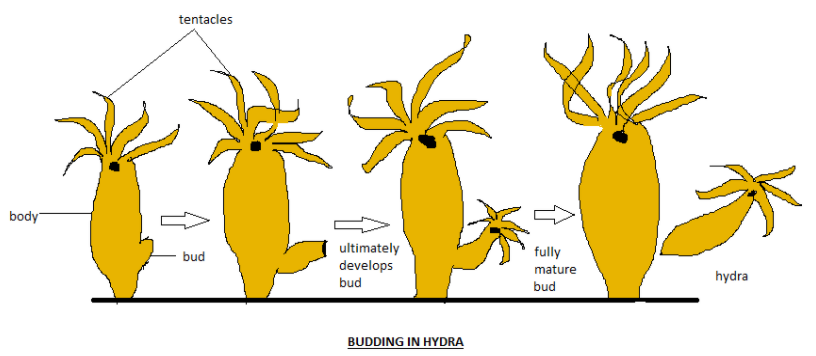
What is budding? Explain the budding in Hydra by the help of diagrams.
Answer
411.6k+ views
Hint: Budding is the process of production of new organisms. It is an asexual mode of reproduction. Examples of budding are yeast, hydra, corals, jellyfish, etc. It is associated with both unicellular and with multicellular organisms.
Complete answer:
>In budding, a new individual developed from a small part of the parent. A bud that is formed during budding detaches itself from the parent body and develops into a new organism. At the time of separation, a new individual leaves scar tissue behind them.
>Budding in hydra takes place by the regenerative cells in which bud extends as an outgrowth as shown in the diagram. These buds develop into a new organism which detaches them from the parent body at the time of maturation.
>Hydra is found in freshwater. It is small and has a tubular structure that is composed of tentacles. In hydra, budding involves a small bud which is developed from their parent hydra by the help of mitotic cell division.
>Small buds receive protein and nutrition from the parent hydra. They grow healthy and their growth starts by developing mouth and small tentacles. Finally, hydra separated from their parent body and became an independent organism.

Note:As budding is a type of asexual reproduction. So, a newly developed individual is a replica of their parents and they are genetically similar. Budding takes place in unicellular organisms as well as multicellular organisms. Both hydra and yeast can be reproduced by the help of budding.
Complete answer:
>In budding, a new individual developed from a small part of the parent. A bud that is formed during budding detaches itself from the parent body and develops into a new organism. At the time of separation, a new individual leaves scar tissue behind them.
>Budding in hydra takes place by the regenerative cells in which bud extends as an outgrowth as shown in the diagram. These buds develop into a new organism which detaches them from the parent body at the time of maturation.
>Hydra is found in freshwater. It is small and has a tubular structure that is composed of tentacles. In hydra, budding involves a small bud which is developed from their parent hydra by the help of mitotic cell division.
>Small buds receive protein and nutrition from the parent hydra. They grow healthy and their growth starts by developing mouth and small tentacles. Finally, hydra separated from their parent body and became an independent organism.

Note:As budding is a type of asexual reproduction. So, a newly developed individual is a replica of their parents and they are genetically similar. Budding takes place in unicellular organisms as well as multicellular organisms. Both hydra and yeast can be reproduced by the help of budding.
Recently Updated Pages
What percentage of the area in India is covered by class 10 social science CBSE

The area of a 6m wide road outside a garden in all class 10 maths CBSE

What is the electric flux through a cube of side 1 class 10 physics CBSE

If one root of x2 x k 0 maybe the square of the other class 10 maths CBSE

The radius and height of a cylinder are in the ratio class 10 maths CBSE

An almirah is sold for 5400 Rs after allowing a discount class 10 maths CBSE

Trending doubts
Who was Subhash Chandra Bose Why was he called Net class 10 english CBSE

Write an application to the principal requesting five class 10 english CBSE

What are the public facilities provided by the government? Also explain each facility

What is Commercial Farming ? What are its types ? Explain them with Examples

Complete the sentence with the most appropriate word class 10 english CBSE

Find the area of the minor segment of a circle of radius class 10 maths CBSE




